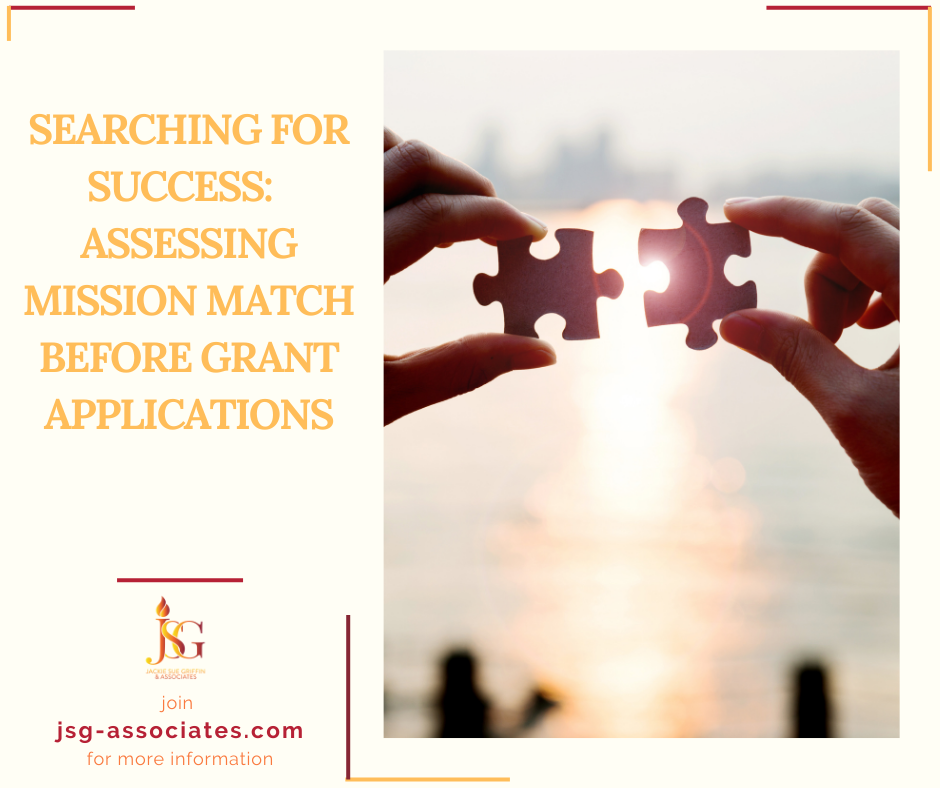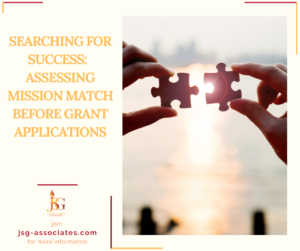
14 Nov Navigating Success: Strategically Assessing Mission Match Before Grant Applications

Written by Jackie Sue Griffin
In the dynamic landscape of non-profit organizations, securing grants is a critical venture that demands more than just a compelling proposal. The journey of grant acquisition requires a strategic alignment between your organization’s mission and the goals of potential funders. Successful grant acquisition is a nuanced process that begins with a thorough evaluation of the mission match.
The Essence of Mission Alignment
We understand each organization has a unique mission—a statement that embodies its purpose, values, and the positive change it seeks to bring to the world. Mission alignment refers to the seamless connection between your organization’s mission and the goals and priorities of potential grantors. This process is about finding a shared commitment to making a meaningful impact.
The Grantor’s Perspective
Potential funders, whether governmental bodies, private foundations, or corporate entities, have specific priorities and areas of focus. Understanding these priorities is fundamental to identifying mission match opportunities. Grantors are not just looking for impactful projects; they are seeking partnerships with organizations that resonate with their values and contribute to the fulfillment of their missions.
Steps to Ensure a Strong Mission Match
- Thoroughly Understand The Future of Your Mission:
The foundation of a successful grant application lies in a crystal-clear understanding of your organization’s mission. Revisit and articulate your goals, values, and the impact you aim to create. This introspective process not only refines your mission but also serves as the compass for finding the right grant opportunities.
- Research Prospective Funders:
In-depth research on potential funders is the foundation of thorough mission match assessment. Scrutinize their mission statements, delve into the profiles of past grant recipients, and analyze the types of projects they have historically supported. This exploration will reveal whether there’s a natural alignment between your organization and the potential grantor.
- Evaluate Grant Guidelines:
Carefully review the guidelines and criteria given by the grantor. Assess how well your mission and proposed project align with their expectations. Look for specific language or themes that resonate with your organization’s work. This step ensures that your application reflects not only the needs of your organization but also the priorities of the funder.
- Assess Past Recipients:
The history of past grant recipients from the funding organization can provide valuable insights. Analyze the nature of their projects and the impact they’ve made. If you find common ground with these organizations, it’s a positive indicator that your mission aligns with the grantor’s priorities.
- Connect with the Funder:
Establishing a relationship with the grantor before applying can be deeply beneficial. Attend informational sessions, webinars, or reach out directly for clarification on any points of ambiguity. Building a rapport not only demonstrates your genuine interest but also provides a platform for understanding the nuances of the grantor’s mission.
The Benefits of Mission Match
- Increased Success Rates:
Applying for grants that align with your mission significantly increases the likelihood of success. Funders are more inclined to support projects that resonate with their values and goals. A strong mission match lays the groundwork for a compelling narrative that captures the grantor’s attention.
- Enhanced Credibility:
Beyond securing funds, a well-aligned mission enhances your organization’s credibility. It displays a genuine commitment to the issues and causes that matter to both your organization and the funder. Credibility is the key to opening doors to broader support and partnerships.
- Long-Term Partnerships:
A well-established mission match creates the potential for long-term partnerships. Funders who see consistent alignment are more likely to become ongoing supporters. This fosters a sustainable relationship that goes beyond a single grant, contributing to the stability and growth of your organization.
Broadening the Scope: Beyond Grant Acquisition
The benefits of assessing mission match extend beyond the immediate success of grant applications. This strategic approach can inform broader organizational improvements:
- Optimizing Resource Allocation:
Understanding where your mission aligns with potential funders allows for strategic resource allocation. It ensures that your efforts are concentrated on projects that resonate with both your organization and the grantor, maximizing the impact of your initiatives.
- Recognizing Exceptional Efforts:
Mission match data provides a foundation for recognizing and rewarding exceptional volunteer and staff efforts. Acknowledging these contributions fosters a positive and appreciative organizational culture, contributing to increased motivation and dedication.
The Future of Grant Acquisition: Technological Integration
As technology continues to advance, organizations can leverage sophisticated tools to streamline the mission match assessment process. Integrating analytics into your research allows for deeper insights into potential funders’ priorities, enabling more efficient decision-making. Predictive analytics may even enable organizations to anticipate shifts in funder priorities, ensuring sustained alignment over time.
Before embarking on the intricate process of grant applications, take the time to assess and ensure a strong mission match. It’s not just about securing funds; it’s about building relationships with funders who share your passion for making a positive impact.
Click here to learn more about how JSG & Associates can help your nonprofit.

No Comments